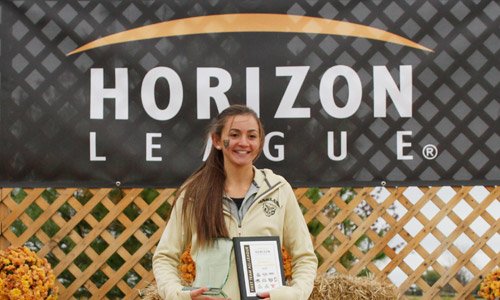Athletics
Athletics
Winter 2016
| by Fritz Reznor
Pay for Play
NCAA approves stipends to offset student athlete expenses
For decades, the debate about whether to pay student athletes above what they receive in scholarship money has continued. Both sides make compelling arguments.
 |
| Women’s soccer coach Margaret Saurin must consider international expenses when allotting her CoAs. Women’s basketball head coach Jeff Tungate appreciates that CoAs help with recruiting. |
Last January, representatives of the NCAA Power 5 conferences ― the Big Ten, Big 12, Southeastern Conference, Atlantic Coast Conference and Pac 12 Conference ― approved by a near-unanimous vote the payment of a “Cost of Attendance (CoA)” stipend for student athletes at their member schools.
A few months later, the Horizon League Board of Directors and Executive Council passed a measure that each Horizon League men’s basketball program can offer 13 CoA scholarships and at least the equivalent amount for women student athletes for gender equity purposes.
Last summer, the NCAA announced it would contribute $18.9 million to its more than 350 Division I member institutions — approximately $55,000 per school — to help offset the CoA costs.
“Basically, the CoA captures some items that aren’t part of the full grant-in-aid,” Oakland Director of Athletics Jeff Konya said. “Cost of attendance is everything: tuition, fees, room, board, books, travel, miscellaneous expenses, supplemental materials, a computer, cell phone — however that fits into the equation. What we’ve done in the NCAA is attach the term ‘CoA’ to that ‘miscellaneous expenses’ category.”
Konya said Oakland will have 31 CoA scholarships at its disposal. In addition to men’s basketball, three Golden Grizzlies' women’s programs will offer CoA stipends: volleyball, soccer and basketball. The stipends, each “a little less than $2,000 per year,” will phase in over two to three years.
Oakland was proactive in determining those factors and had its process in place before the start of the 2015-16 academic year. Many NCAA institutions were still trying to figure out the logistics of their CoAs ― which student athletes would receive them, the amount, how and when to distribute them.
“At the time, we allocated our first CoAs to our volleyball players,” Oakland head volleyball coach Rob Beam said. “They were the first two student athletes who played volleyball in the Horizon League to be awarded a CoA. Oakland was the only Horizon League school that had implemented CoA for any student athlete, and I give credit to Jeff and the administrative team for that. We’re on the right side of it, and we’re at the forefront.”
Beam said the CoAs can help his staff compete during recruiting against other programs.
“When you can come to the table with a financial package that is equal to or better than a Big Ten or ACC program, and a history of winning matches against Power 5 teams, and of winning championships, it puts Oakland in an even better light,” he said. “And I’ve always considered Oakland to be one of the more attractive options, regardless of era or success.”
Coaching at Oakland for more than 30 years, men’s basketball coach Greg Kampe has been bound by strict NCAA rules. “I couldn’t even buy someone a toothbrush,” he said.
The new rule, he said, is “long overdue. College basketball is a business, and it’s a big business. The student athletes are the people who drive it, so any type of compensation that they can get is good. In the past, we’ve had kids who were forced to just stay in their room and not do stuff because they just didn’t have the ability to do it.”
With 11 of her current student athletes living outside the United States, women’s soccer coach Margaret Saurin deals with a different set of circumstances when allotting her CoAs.
“We’re always trying to get the best kids out of Michigan,” she said. “This could give us a competitive advantage over the other state schools.
"We’ll also use it for international players, whether they’re from Canada, Europe or South America, now that we’ve opened up that market," Saurin continued. "A lot of those kids come from families where there isn’t a savings for a college education, and a college education can only come to fruition from playing soccer. International students have other expenses, like costly flights to get home twice a year, and international insurance.”
Golden Grizzlies' women’s basketball head coach Jeff Tungate appreciates that CoAs help with recruiting. However, he said prefers to focus on the long-term benefits of an Oakland education.
“It’s nice that the student athletes are able to receive CoAs, and I know that our players appreciate that,” he said. “But the important thing is, what are you going to do once you get your degree from here? I’d rather make sure they’re set up for the next 40 years, because that amount of money is going to be a lot more than what they’re getting now.
"In the long term, it’s still the quality of the degree they’re going to receive from Oakland University and the quality of the experience they’ll receive from playing on our basketball team that’s going to make them successful in life.”
Fritz Reznor is a freelance writer from Pleasant Ridge, Michigan.


